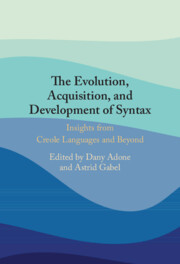Book contents
- The Evolution, Acquisition, and Development of Syntax
- The Evolution, Acquisition, and Development of Syntax
- Copyright page
- Contents
- Figures
- Tables
- Contributors
- Acknowledgments
- Abbreviations
- 1 Introduction
- Part I The Evolution of Syntax
- Part II The Acquisition of Syntax
- Part III The Development of Syntax
- Index
- References
1 - Introduction
Published online by Cambridge University Press: 19 February 2025
- The Evolution, Acquisition, and Development of Syntax
- The Evolution, Acquisition, and Development of Syntax
- Copyright page
- Contents
- Figures
- Tables
- Contributors
- Acknowledgments
- Abbreviations
- 1 Introduction
- Part I The Evolution of Syntax
- Part II The Acquisition of Syntax
- Part III The Development of Syntax
- Index
- References
Summary
“Syntax lies at the very heart of what it means to be human” (Bickerton & Szathmary 2009: xviii). It has been argued that no other species has been able to acquire a rudimentary syntax, thus reinforcing the view that acquiring syntax is a unique ability of humans (Bickerton & Szathmary 2009). The present volume describes the current state of the discussion on syntax with a special focus on Creole languages. It sheds light on the relevance of syntax in Language by bringing together scholars from the fields of language evolution, language acquisition and development of young languages, that is, Creoles.
Information
- Type
- Chapter
- Information
- The Evolution, Acquisition and Development of SyntaxInsights from Creole Languages and Beyond, pp. 1 - 8Publisher: Cambridge University PressPrint publication year: 2025
